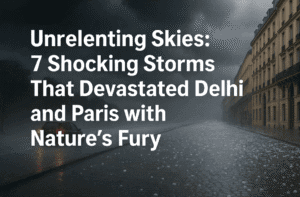Unrelenting Skies: 7 Shocking Storms That Devastated Delhi and Paris with Nature’s Fury
Delhi’s pre-dawn thunderstorms last week unleashed chaos, claiming seven lives with 77 mm of torrential rain—the second-highest May rainfall in 124 years—triggering flash floods, uprooting trees, and paralyzing infrastructure. Simultaneously, Paris endured marble-sized hailstones that buried streets and flooded metro stations, as a volatile low-pressure system swept from Iberia into northern Italy, sparking amber storm warnings. In India, erratic weather persists: Gujarat and Rajasthan brace for thunderstorms this week, while Surat’s temperatures drop 8°C below seasonal norms, offering fleeting relief from April’s deadly heatwaves.
Meteorologists link Delhi’s unprecedented storm to clashing air masses—scorching surface heat colliding with cooler upper currents—a pattern complicating forecasts. Europe’s hail, fueled by temperature contrasts, underscores a climate paradox: rising heat intensifies both droughts and deluges. These events spotlight vulnerabilities in urban resilience, urging cities to prioritize adaptive infrastructure as volatile weather becomes the new norm. From flooded metros to fatal floods, the message is clear: preparedness is no longer optional.

Unrelenting Skies: 7 Shocking Storms That Devastated Delhi and Paris with Nature’s Fury
As spring transitions to summer, two iconic cities—Delhi and Paris—found themselves at the mercy of violent weather systems, underscoring the unpredictable power of nature and the urgent need for climate resilience.
Delhi’s Deadly Deluge: A Night of Chaos
In the early hours of Friday, Delhi and its neighboring regions were jolted awake by thunderstorms that unleashed torrential rain, golf ball-sized hail, and winds strong enough to uproot trees. The Safdarjung weather station recorded 77 mm of rain, with 60 mm falling in just three hours—marking the second-highest May rainfall in over a century. The aftermath was dire: flash floods submerged streets, collapsing structures claimed seven lives, and infrastructure disruptions left thousands stranded.
Why This Storm Stands Out
The event defied typical pre-monsoon patterns. While May often brings scattered thunderstorms, the intensity and duration of this system were exceptional. Meteorologists point to an unusual clash of cooler upper-air currents colliding with India’s scorching pre-monsoon heat, creating a perfect storm scenario. This instability is expected to persist, with Gujarat and Rajasthan bracing for similar conditions midweek. Temperatures in Surat, Gujarat, may plunge to 30°C—a stark contrast to April’s 45°C heatwave, offering fleeting relief but raising concerns about erratic seasonal shifts.
Paris Under Ice: Hailstorms Transform Streets into Rivers
Meanwhile, 4,000 miles west, Paris faced its own meteorological nightmare. A low-pressure system sweeping from Iberia triggered violent hailstorms across northern France. The City of Light was pummeled by marble-sized hail, turning cobblestone streets into icy rivers and forcing four metro stations to close. The storm’s eastward trajectory now threatens northern Italy, where amber warnings signal potential flooding and wind damage.
The Science Behind the Storms
- India’s Thunderstorms: Convection—a process where warm, moist air rises into cooler atmospheric layers—drove Delhi’s deluge. Predicting such events remains challenging due to their localized and sudden nature.
- Europe’s Hail: The Iberian low-pressure system pulled cold air into warmer surface temperatures, creating updrafts that supercooled raindrops, forming destructive hailstones.
Climate Connections: From Heatwaves to Hail
These events highlight a paradoxical trend. In India, record-breaking April heatwaves (linked to warming trends) dried soils, reducing their capacity to absorb sudden rainfall—exacerbating flooding. In Europe, rising temperatures may intensify convective storms, making extreme hail more frequent. While direct attribution to climate change requires deeper analysis, the pattern aligns with IPCC warnings of heightened weather volatility.
Looking Ahead: Vigilance in a Volatile Climate
For Delhi, the week promises little reprieve, with forecasts of renewed thunderstorms. Residents are urged to heed real-time alerts and avoid flood-prone areas. In Europe, Italy’s Po Valley faces critical flood risks, testing the region’s preparedness.
The Takeaway
These storms are a reminder of nature’s dual capacity to disrupt and humble. As cities expand, integrating weather resilience into urban planning—from reinforced drainage systems to public warning networks—becomes non-negotiable. For now, the focus remains on recovery, adaptation, and respecting the skies’ unpredictable might.
You must be logged in to post a comment.